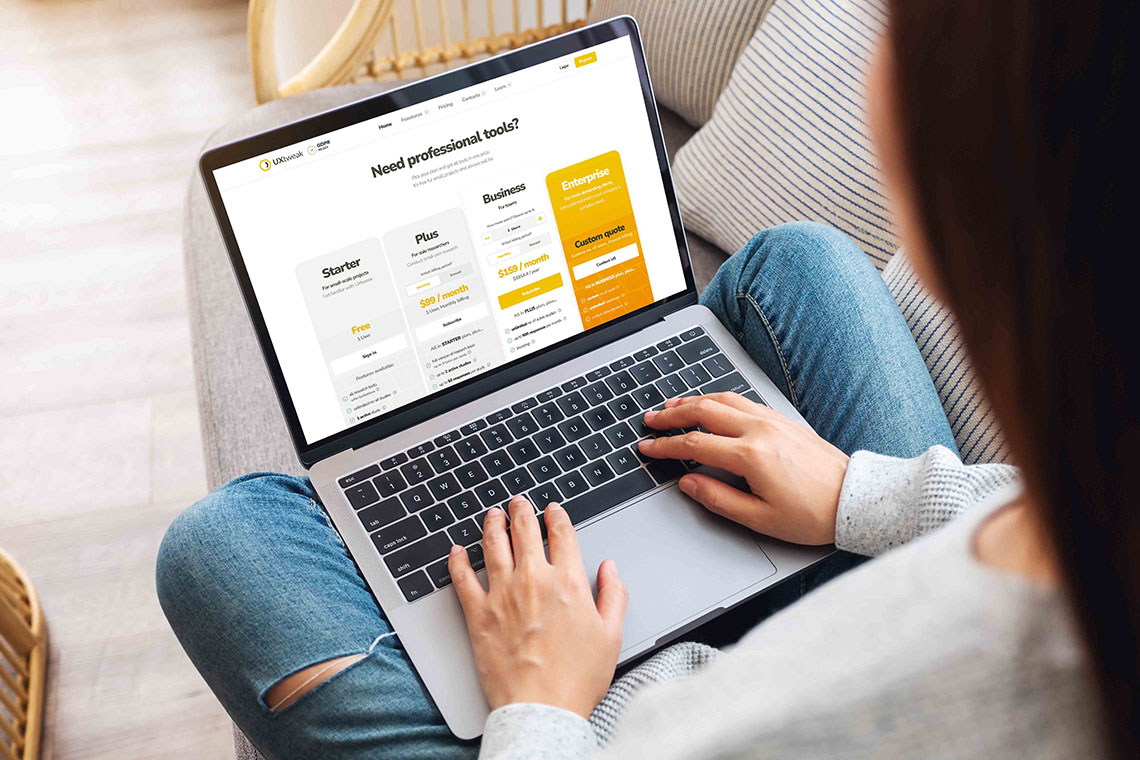They say prevention is better than cure and it’s 100% true when it comes to UX design. It’s better to be aware of common UX design mistakes and their causes, rather than spend a fortune fixing their consequences later on.
Let’s explore some of the common mistakes designers make and see what you can do to prevent them!
Why is flawless UX design so important?

Now, we can all agree that “flawless” is a big thing to say about any design. Most of the products we see online are not flawless and are constantly being tested and iterated upon.
However, the reason we talk about flawlessness here is because it’s something all products should thrive for. The goal is to constantly improve your product and fix any issues that arise so there are no flaws left.
Even the smallest usability issue a user encounters can become crucial and significantly influence the way they perceive your product. This leaves a stain on the UX your product provides, which may later result in lower conversions and decreased customer satisfaction.
That’s why, even though mistakes can occur, as designers, we should do our best to prevent them and deliver an already user-friendly product to our future customers.
Luckily, there’s a way to do that. And that’s by being aware of some of the most common UX design mistakes and ways to avoid them!
10 most common UX design mistakes and how to fix them

- Designing for yourself, not the user
- Weak information hierarchy and poor navigation
- Cluttered design
- Not labeling icons
- Wrong use of CTAs
- Lack of mobile responsiveness
- Lack of focal point
- Not gathering user feedback
- Lots of animations
- Ignoring usability testing
Let’s look at this list in more detail and see what you can do to prevent these mistakes from occurring with your digital product.
1. Designing for yourself, not the user
One of the most common and crucial mistakes we face till this day is the absence of user research as a whole. Many organizations still underestimate the value of research and skip the most important part of the UX design process: getting to know the user, their needs, expectations and pain points that your product is going to solve.
Without proper user research, the products are designed to fit the expectations and wants of the relevant stakeholder, without taking the end-users into account. Therefore, as a result, users often do not like or understand the product intended for them, making them leave and choose the competitor’s product instead.
How to avoid it?
Make sure that user research is always a part of your design process and implement it in the early stages to gather information about users needs and expectations of the product. This will allow you to gather enough information to inform future design decisions and create a product with the user in mind.
Some of the ways you can implement research at early stages of product design are: surveys, interviews, concept tests, preference tests etc.
2. Weak information hierarchy and poor navigation
Failing to prioritize and structure information effectively is another critical mistake that companies make. When you design your website architecture and navigation, it’s crucial to make sure the structure aligns with users expectations of it, is intuitive and easy to navigate.
Otherwise, users are left with confusing menus and weird content categorization that doesn’t make sense to them. Effective navigation is the foundation of good UX, and therefore, it’s important to make sure that users are able to navigate their way through your product as easy as possible.
How to avoid it?
To avoid this problem you need to introduce a user-centric approach when designing the information architecture (IA) of your product. To make sure your content is structured in a way that makes sense for the user, you need to involve them in the IA design process.
There are two handy tools that can help you with that.
Start designing your information architecture by conducting an online card sort with your users. This will give you a clear idea of how they expect the content to be structured and labeled. Based on the results of your card sorting, come up with 2-3 alternative versions of your future IA.
Conduct a tree test on all of them to evaluate their intuitiveness and let users decide which one performs best.
The final version will be your ideal navigation structure according to users. You can now be sure that your content organization corresponds to their expectations and they are able to easily locate any information on your website or app.
See Card Sorting and Tree Testing in action in these demos:
3. Cluttered design
Trying to squeeze too much information and design elements on one page often results in clutter and cognitive overload, making it hard to grasp the key message of the page. Clustered designs often lack whitespace and cause readability issues, confusing structures and layouts, not to mention they just look messy.
When users find themselves on such pages, they usually don’t have the energy to go through all that loads of information, so, instead, they just leave. This is a nightmare for the product owner, as, due to this clutter, visitors are unable to locate key information on the page or perform a certain action, which results in poor low conversions and higher bounce rates.
How to avoid it?
Simplify your layouts. Only include the most important information in the design and make sure it’s organized in a structured manner. Use grids, hierarchy, and visual cues to guide users’ attention.
And don’t forget about the white space! It makes it easy for users to scan information and helps to reduce cognitive load to minimum. Avoid putting unnecessary elements on your pages and remember – less is more.
4. Not labeling icons
Another one of UX design mistakes is that we often see mostly in mobile apps is choosing to not label your icons. This, however, is usually done with the best intentions in mind. Designers are trying to keep designs minimalistic and not overload them with “useless” labels (in their opinion).
This approach, however, often results in poor usability.
First of all, with this decision designers compromise the inclusivity of their product. Second of all, many commonly used icons mean different things on different websites, making it hard for users to understand what is going to happen after they click it. Complex, rarely used icons, on the other hand, may be hard to understand for the person who is using your product for the first time.
How to avoid it?
The solution is quite simple – label your icons. Even though in some cases it may not be necessary due to some universal symbols, like the shopping cart icon, most of the time it’s better to provide context to your users.
This can be done in a minimalistic way, without introducing cognitive overload, and will actually enhance usability and UX of your product.
5. Wrong use of CTAs
Another common mistake, mostly across company and personal websites is an unclear use of CTAs. Weak CTAs often result in low conversions, as users are unsure of what you want them to do with your product. This can occur due to poor CTA design or generic and unengaging button text that doesn’t encourage users to take action.
How to avoid it?
Place your CTAs strategically and make sure that clearly communicate the action you want users to take. Use contrasting colors and make sure your buttons are big enough for users to locate and click on them. Additionally, come up with actionable CTA button text that will motivate users to click and engage with your product further.
To test if your CTA buttons work as intended, we recommend to use a Session Recording tool and analyze heatmaps. This will give you a clear idea of how users navigate your product, where they click and if CTAs attract as much of their attention as intended.
You can then analyze session replays and iterate your designs based on the collected data.
Check out how Session Recording work in these demos:
6. Lack of mobile responsiveness
While most website owners do their best to fine-tune the desktop version of their product, mobile responsiveness often gets overlooked. In the age of portable devices users navigate most websites through their phone, meaning it’s crucial to make sure your website’s mobile version works just as good as the desktop one.
How to avoid it?
The optimal way to ensure this problem will not affect your product is conducting mobile usability tests. You can do that with the help of an online Mobile Usability Testing Tool. The main benefit of this UXtweak’s feature is that it allows you to test all kinds of mobile interfaces: applications, beta versions of your app from AppStore, mobile prototypes and mobile website versions.
This is an ultimate tool that helps you find out how users interact with your mobile interface, see it’s from their POV and pinpoint critical issues that need to be fixed.
7. Lack of focal point
Another common mistake is failing to establish a focal point in your design that guides users attention to the most important elements on the page.
Some website pages, for example, tend to have two very prominent elements close to each other, which may be confusing for the visitor. This indicates lack of information hierarchy and may result in users not getting the page’s message or not noticing your CTAs.
How to avoid it?
Create a distinct focal point by using size, color, contrast, or positioning to draw attention to the most important element. This will help to guide users’ gaze on the page and allow you to direct their attention towards the most important elements.
To test if your focal points are clear, conduct a quick five second test using UXtweak’s Five Second Test Tool.
It will help to find out how users remember your designs after just a few seconds of first impression and show if they are able to successfully grasp the message you’re trying to communicate.
8. Not gathering user feedback
After the product is released on the market, user feedback should be the drive of any future iterations. Failing to provide ways for users to share their feedback or deciding that you’re not going to collect it at all will stop your product from growing and affect the level of users’ trust.
How to avoid it?
Make sure to constantly seek and encourage feedback. You can do so by providing multiple ways for your users to share it on your website or app. This can include chatbots, popup surveys, feedback widgets, contact forms as well as multiple ways to reach out to customer support.
9. Lots of animations
This mistake is often the result of companies trying to hop on some of the latest design trends without thinking about how it may affect the overall usability of the product. Complex animations often take more time to load and putting them where unnecessary may result in poor product performance. This can include slow loading times, bugs or just user confusion.
How to avoid it?
Don’t overload your website with animations. Even though it may look impressive, make sure you don’t compromise usability when implementing them in your designs. Go for easy animations that don’t confuse the user and don’t take ages to load.
10. Ignoring usability testing
The last and the worst UX design mistake if you ask us. Usability testing should be an integral part of your design process as it allows you to quickly pinpoint usability issues and uncover insights on how users interact with your product. Ignoring usability tests throughout the product development process will most likely result in poor usability and UX.
How to avoid it?
The solution here is to incorporate usability testing in your design process and conduct it continuously, from early prototyping stage till the final launch of the product. This approach will allow you to pinpoint issues early on and iterate your designs based on actual insights from users.
You can conduct all types of usability tests with UXtweak!
Use our Website Testing Tool to evaluate the usability of your website, conduct prototype usability tests on your designs with our Prototype Testing Tool and test your mobile apps with Mobile App Testing Tool.
Best practices to avoid UX design mistakes

Here are some of the additional best practices you can follow to avoid the design mistakes we discussed above:
- Conduct user research: get to know your users before you start creating the product. That’s how you’ll ensure it appeals to the target audience.
- Prioritize information hierarchy: this goes for both navigation and layouts. Make sure your content is structured and organized in an intuitive way.
- Use white space: this will help to keep your designs clean, visually appealing and avoid clutter.
- Ensure accessibility: follow best practices of accessibility to ensure that your product is usable by individuals with disabilities.
- Design with users in mind: always put users in the center of your decisions, iterate based on their feedback and empathize with them in order to create a product that actually solves their problem.
- Test and iterate: conduct regular usability tests to pinpoint issues early on and ensure your product is providing a good user experience.
Wrapping up
Now that you’re aware of 10 most common UX design mistakes you can do your best to prevent them and ensure the flawless UX of your product.
Register for your UXtweak account and use it to help you uncover and fix UX design mistakes on the spot!







